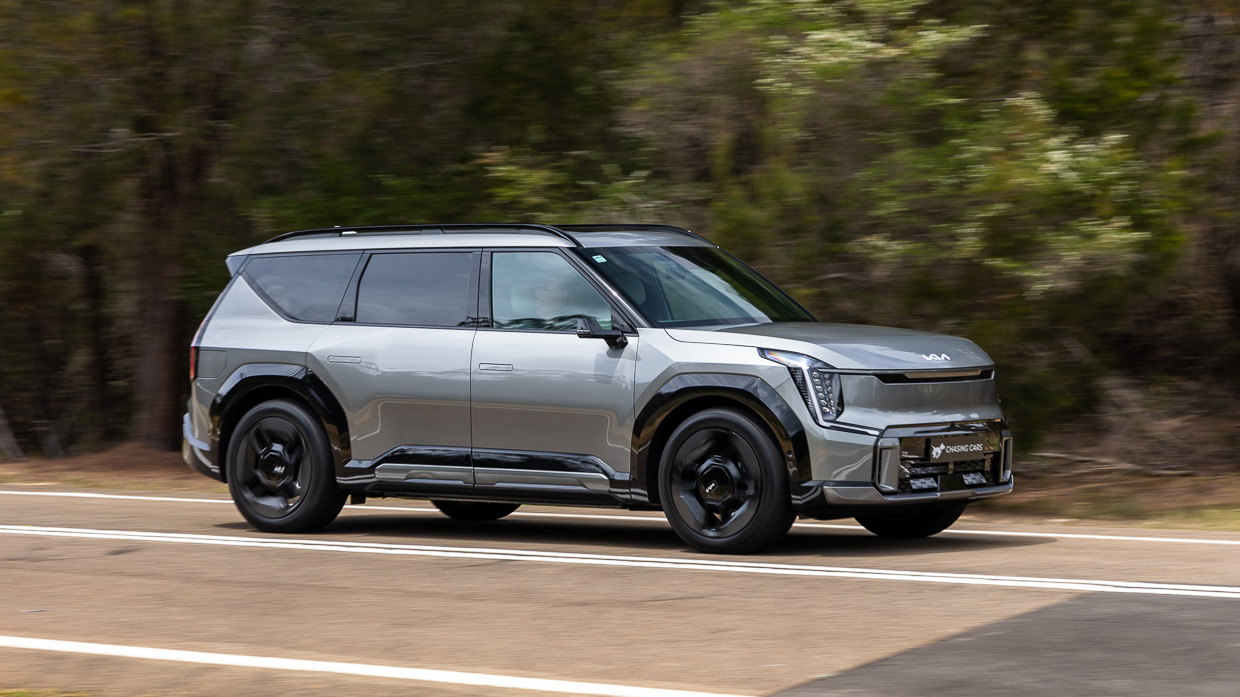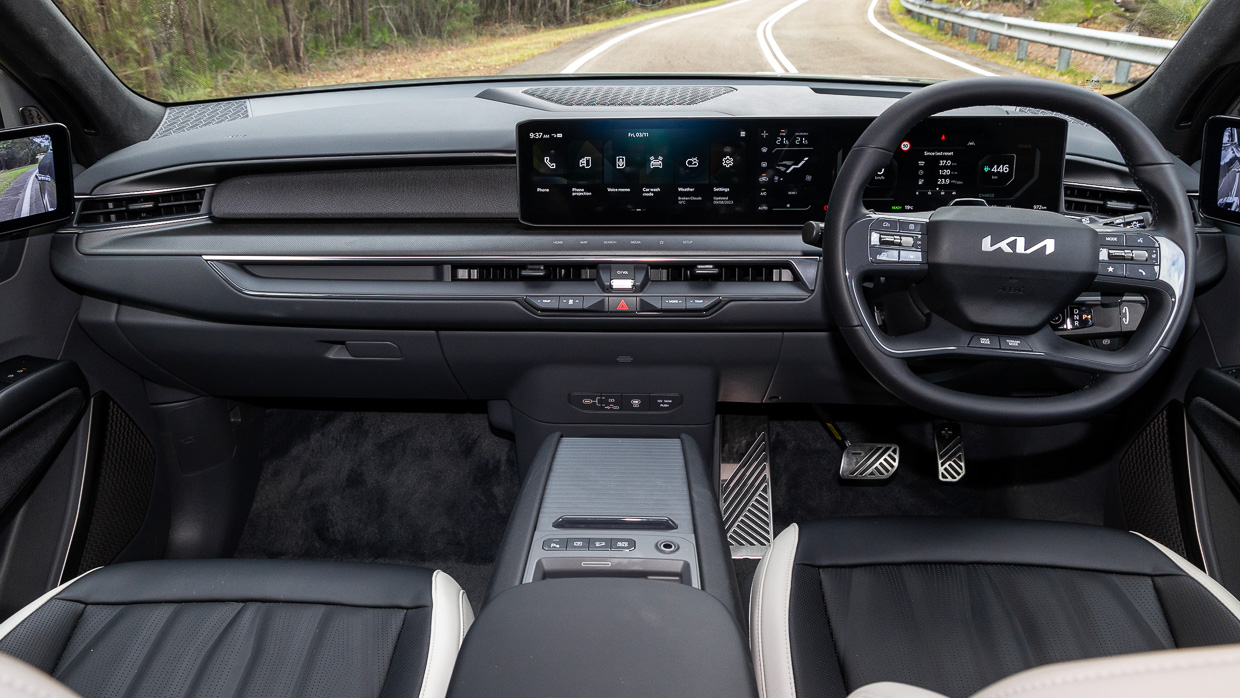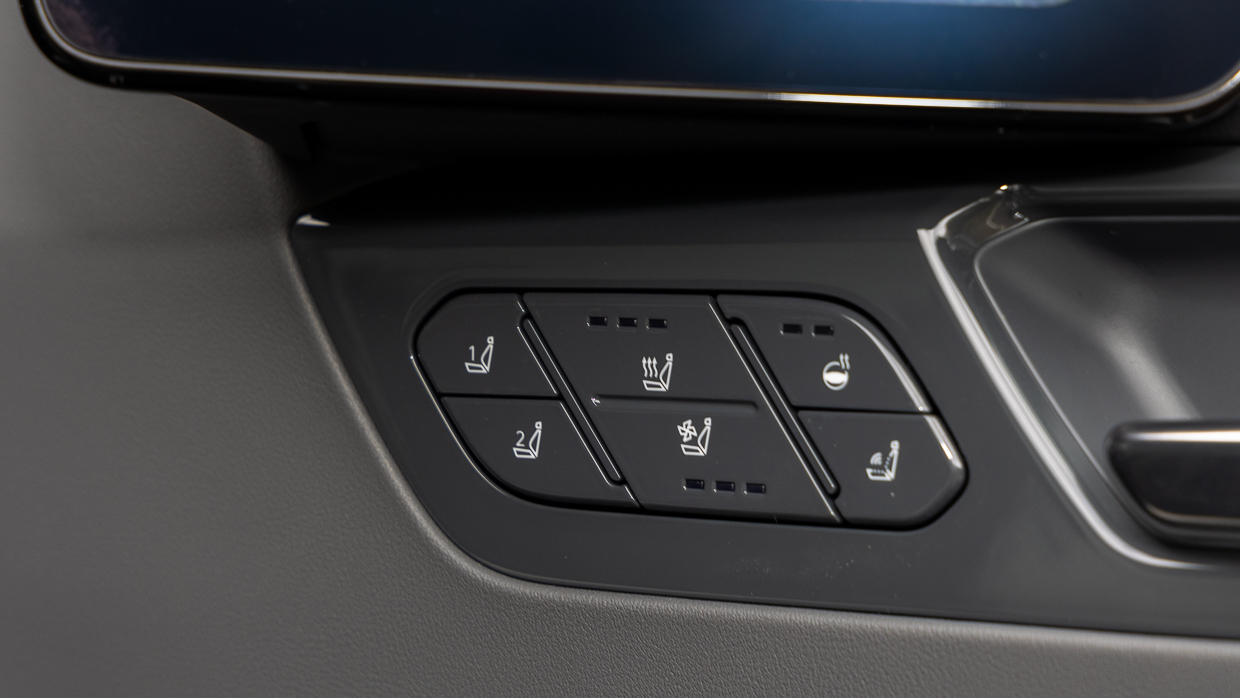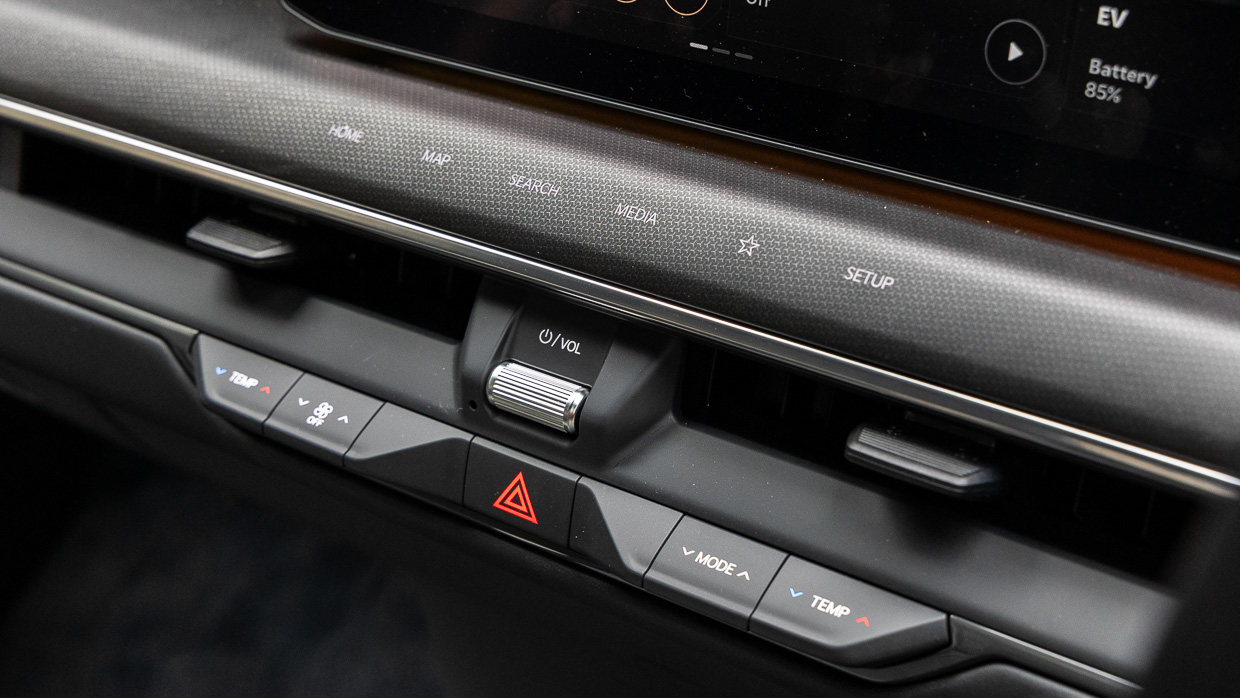-
Car Reviews
- All reviews
- Midsize SUVs
- Small cars
- Utes
- Small SUVs
- Large SUVs
- Large cars
- Sports SUVs
- Sports cars
- Vans
Latest reviews
- Car News
-
Car Comparisons
Latest comparisons
- Chasing Deals
Much is riding on the considerable shoulders of this landmark three-row electric SUV for Kia – and it’s so good that premium Euro marques should be worried
Spoiler alert: the Australian version of the Kia EV9 is as good as we could’ve reasonably hoped.
Kia’s large electric seven-seat SUV isn’t perfect, but it nails the landing on a long list of key areas that, when combined, warrants the accolade of a watershed mainstream model. And it’s potentially a real game-changer.

The EV6 midsize electric crossover might’ve sounded the warning, but it’s really the EV9 where Kia has, in one model, broken through the wall that divided the Korean mainstream and premium Europe.
Given the significant degree of difficulty in doing so with a complicated electric three-row upper-large SUV – a segment with a broad brief – this is a truly impressive achievement.
One high degree of difficulty is price. The three-variant EV9 range tops out at $121,000 before on-road costs. Yes, for a Kia.

But after two trips to drive Korean versions in their homeland, plus a local launch program with both entry Air and flagship GT-Line versions followed by a week-long stint with the flagship in the Chasing Cars garage, it’s tough to find a challenger that covers quite so many bases quite so impressively, wearing any badge, and at any price.
This glowing assessment isn’t merely down to sheer performance or the sheer number of pleasing features the range-topper boasts, and it offers plenty of both.
Instead, it’s simply that the EV9 is so well executed in what it sets out to achieve: a fine, electric, plus-sized family hauler, one that’s refined, hugely practical and consummately comfortable.

And if our first drive of the Aussie lineup is genuine, the electric newcomer is as much even in its entry $97,000 Air guise without the GT-Line’s performance prowess or gushing frills.
The jury is out on the mid-range Earth variant: at $106,500 list, which will follow the Air and GT-Line into showrooms early 2024.
Given it’s $14,500 thriftier than the GT-Line, while packing the same 283kW and 700Nm dual-motor big-battery goodness and boasts the highest range claim of the lineup (at 512km), the Earth could potentially be the sweetest spot in the range…
There’s much to unpack with what has been framed as the world’s first mainstream electric seven-seater. No less that premium European marques such as Audi, BMW and Volvo have no direct challenger for its recipe. Nor does Tesla in Australia for that matter.

The only other upper-large electric seven-seat Aussies can buy right now is the Mercedes-Benz EQS SUV that, at $195K, is twice the price of an EV9 Air.
We’d covered off most of the ‘what it is’ stuff back in our first drive content in Korean. So here, instead, the focus is what it’s like in Australian trim levels and spec – complete with locally developed suspension and steering tuning – and how it fares in a familiar environment.
Unsurprisingly, it’s the GT-Line we spent the lion’s share of time with, though we did get a decent sample of the entry Air version during Kia Australia’s two-days launch program.
The three-variant EV9 range kicks off at $97,000 with the entry-level Air, the only EV9 variant to fit the single-motor rear-wheel-drive format outputting 160kW and 350N paired with the circa-74kWh usable battery.
Its range claim is 443km while offering a promise of 8.2sec 0-100km performance.

Pictured: the EV9 Air
The Air features highlights include:

Pictured: the Air and GT-Line grade, left to right
The $9500 walk up to the ($106,500 list) Earth mid-ranger brings the dual-motor AWD format with combined outputs of 283kW and 700Nm paired with the larger circa-95kWh usable battery. Range grows to a claimed 512kms with performance dropping to 6.0sec claimed.
The Earth adds a selection of features above the Air grade that includes:
There is significant $14,500 jump from the Earth to the flagship GT-Line AWD ($121,000 list), which comes with the 283kW/700Nm dual-motor and 95kWh usable battery, if with sharper 5.3-second 0-100km/h performance – a specific drive mode software tune, says Kia – and 505km of claimed range.

For its flagship positioning and extra outlay, the GT-Line fits:
Absent from the local lineup is the choice of a longer-range, big-battery, single-motor format offered in other markets.
Why? The single-motor format only offers 900kg of braked towing capacity, compared with 2500kg for the dual-motor versions.

According to Kia Australia, a big-battery RWD version would have to split the Air and Earth on price, making it just a few thousand dollars cheaper than the vastly lustier, stronger-towing AWD Earth.
Six colours are offered in all three grades, with a bespoke matte ocean blue reserved for the GT-Line.
The ride and handling tuning is the most Australianised facet of EV9, so it’s a good place to start. It’s an area Chasing Cars spent some time discussing with Kia Australia’s chief ride and handling engineer, Graeme Gambold.
The EV9 lineup fits either EV-specific 255/60 19-inch Nexen or Kumho eco tyres for the Air and Earth grades, or whopping 285/45 21-inch Continental rubber on the GT-Line. These are the choices of Kia’s global HQ, rather than Australia.

Using these tyres, Gambold’s local team proceeded to develop two suspension tunes, one for RWD and one for AWD.
Mixed and matched, the result is three different combinations – the Air’s 19in/RWD, the Earth’s 19in/AWD and the GT-Line’s 21in/AWD – for potentially three distinctive ride and handling results.
The RWD tune is, Kia says, softer riding and rolling, and is more rough road capable. Meanwhile, the AWD suspension is generally firmer, sits flatter and focuses on mid-corner response and grip.

However, Gambold explains that the five-link rear suspension tune is essentially the same across the board, and it’s the strut front ends that vary most significantly from RWD to AWD.
Interestingly, Gambold swears the low-profile Contis have softer sidewall squish than the EV-spec Nexens (specifically) and is open to the fact the 21-shod GT-Line received the lion’s share of R&D in the range.
Still, our EV9 experience kicked off with a couple of hours at the helm of the Air and we came away thoroughly impressed.
At 2312kg, the RWD versions significantly lighter than the 2636kg all-paw GT-Line and its softer tuning is composed enough in body control and neatly compliant across a range of surfaces, from crook inner-city Sydney roads to flowing coastal curves to open highways south of Wollongong.

The steering – with its rack-mounted electric motor assistance – is pleasant and even if without much feel, though the real boon is how quiet the Air is, right down to the tyres that boast sound absorbing foam beneath the tread.
Not only does the EV9 demonstrate high resilience to noise, vibration and harshness, it feels fantastically solid on the road, which brings with it a luxurious and upmarket manner to this sort of casual touring.
One surprise is the powertrain. Really, 160kW and 350Nm ought to struggle with over 2.3 tonnes to move, though the nature of the electric drive’s instant torque and solid delivery doesn’t feel short changed, at least with two occupants aboard and with nowhere to be in much of a hurry.
When it comes to judging capabilities loaded with family and luggage, however, the jury is still out…

Nor does the EV9 feel lumbering, unwieldy or blunt in the corners.
Its underfloor battery contributes to what feels like a low centre of gravity and an even spread of mass between the axles, bringing a sense of competency if without any natural encouragement to really explore whenever dynamic fringes are at play.
At almost two metres wide the slap of tyres on cat eyes is pretty common, though at just over five metres in length and under 1.8 metres tall it’s not actually as large as it’s flamboyant styling and bluff proportions otherwise suggest.
Further, the EV9 is surprisingly easy to place on the road, though it demands some care when parking in tight spaces.

Nor does it consume electrons as much as you might expect. The Air RWD’s claim is 19.5kWh/100kms combined and with a road loop largely favouring low-speed driving and only brief stints on the open road the indicated consumption sat happily in the mid teens for most of the trip.
While the projected range at kick-off on a full charge looked short of its 443km claim – it was closer to 410km – by trip’s end that target looked very achievable with a sympathetic driving style.
In a nutshell, the Air is a wonderfully fuss-free cruiser, with impressive refinement from both the powertrain and the chassis.

From the moment you touch the throttle of the AWD GT-Line, it’s clearly a more effortless and vastly more potent proposition.
The AWD format brings two 141.3kW and 350Nm motors into play with seemingly no drive preference to either axle, though the constant final gear ratio is shorter on the rear, which might possibly favour some mild rear driven effect in some situations.
Combined outputs are 282kW of power and 700Nm of torque for the GT-Line AWD.
In full-house sport mode, it’ll thrust what amounts to over 2.8 tonnes (with two blokes aboard) to triple figures in 5.3 seconds…or so it’s claimed. Actually: it’s quicker.

With its 566kg lithium-ion 95kWh usable battery brimmed – 100kg heavier than RWD’s 74kWh usable unit – our Pebble Grey example rattled off a stunning 4.77sec pass at the Chasing Cars’ test track with yours truly at the helm.
While that’s hardly record-breaking by today’s EV measures, it’s plenty quick for a full-fruit seven-seat luxury family hauler. In fact, the Kia’s just 0.19sec behind a triple-motor Audi E-tron S to triple figures, as tested.
Thus set, its response to march is instant and heady. There’s a real precision to the throttle response, if without the lightswitch character you experience in some of Tesla’s more potent machinery.

Nor does it demand its most visceral drive mode to boogie – left in normal, there’s fantastic flexibility in its delivery, paired with a hunger to climb steeply inclined – such as the famed Jamberoo Mountain road in NSW’s southern highlands – effortless.
The sheer grip of those 285mm Continentals is fantastic, even while ascending one of Australia’s tightest driver’s roads.
And it’s here that the EV9 demonstrates an uncanny ability to stay composed and put its torque and drive to ground, even with the radical camber changes of the road’s hairpins.
If there’s a downmark, it’s that steering is somewhat aloof unless you dial up the sport drive model.

In its mildest economy drive mode, it disconnects front-axle drive to reduce parasitic loss and improve range (conditionally). Advertised consumption for the heaviest variant of the lineup is 22.8kWh/100km with a range claim of 505km. Not too shabby on paper.
We put our GT-Line through the Chasing Cars EV efficiency test and the results were mixed. For urban efficiency, the EV9 returned consumption of 18.7kWh/100kms and a range of 508kms. Around town, it delivers nicely.
However, consumption climbed during the tougher highway cycle, its 23.2kWh/100kms amongst the thirstiest EVs we’ve tested. Open road range, too, drops to 409km.

That said, the GT-Line’s manners as a grand tourer are exemplary. The ride comfort is wonderfully sorted and polished, the bump control of the considerable unsprung mass of the gigantic rolling stock quite remarkable.
It’s not faultless – deep potholes make their presence known – though it is quite impressive given the physics at play are being controlled by a passively damped design.
The front end is firmer than the rear, which is evident over speed bumps, though this local tuning is wholly better than the Korean spec we’d driven in the past.

Like the Air, the GT-Line is wonderfully serene and feels rock solid on road. And NVH suppression is also remarkably good, especially for a rig with such a broad rubber footprint. It’s a very comfortable rig for long hauling, if an experience that’s not without annoyances.
The overspeed warning system we’ve griped about in the past – Seltos, as well as Hyundai Ioniq 6 and Palisade – makes a return here.
It’s three decibels quieter and quicker to switch off than in Seltos, but having to switch it off after every restart infuriates at times. Ditto the vision detection driver attention recognition ‘smarts’, that functionally trip up when the driver wears polarised sunglasses.


The multi-perspective digital wing mirrors are a taste your reviewer has yet to acquire, especially when reverse parking. They’re standard on GT-Line and good old analogue mirrors aren’t an option in Australia. It remains to be seen if Kia backpedals on this decision and makes them optional in future.
The digital interior mirror, though, is beaut. It offers a vastly clearer view in low light than the analogue design, which is also switchable at the flick of a lever. Add the blind spot view monitor in the instrumentation and the array of five camera views is novel if, for some drivers, not entirely necessary.
A $121K Kia SUVs brings plenty of trinkets, but the EV9’s key win is packaging. In every row by every measure it’s larger and roomier than a Sorento, with a nice flat floor and a strong sense of space thanks largely to its near two-metre width and a cabin design that tends to accentuate it.
Expectedly, the first row is comfy, the second row feels cavernous and the third row is cosy but genuinely adult friendly. Adjust the slidable row two bench just so and 180cm tall adults can occupy the rear rows and still have a modicum of knee room in the rearmost seating positions.


Luggage space? It’s 573L as a seven seater, 1233L as a fiver and 2314L converted to surrogate two-seater panel van, the rear seating stowing to a pleasingly flat load space. There are also two frunk sizes: 90 litres for the RWD Air and 52 litres for the AWD variants.
In short, importantly, the EV9 is hugely practical. Third row access is also easy with a one-touch-button flip-forward action for the 40 side of the 60:40 split second row bench…however, the tumbling side is road-side rather than kerb-side, which is a pain.
Storage? The flat floor accommodates some clever oddment solutions around the centre console, including a huge tray at foot level large enough for handbags and larger devices.

There’s a neat inductive charge point under the arm rest beside a deep storage bin, while the cupholders have a neat roller door cover when not in use.
There are large 8.0L (GT-Line) or 9.5L (Air) glove boxes depending on the variant and door bins large enough for bottles.
Cleverly, the EV9 fits a column-mounted by-wire starter/drive selector which essentially frees up access space around the centre console, with USB-C and 12-volt outlets as well as physical controls for audio volume and climate control located logically in easily accessible areas.

Pride of place, though, is the dual 12.3-inch display screens that blend together seamlessly via a central 5.0-inch screen for the front HVAC.
The driver’s display, framed by a neat and slightly hexagonal wheel, offers a clear and simple skin and isn’t very configurable, but the restraint balances nicely with the media screen, which is fancier without going overboard with eye candy.
It’s a smart interior design. Some of it is new to Kia, such as the panoramic three-screen display, the column ‘shifter’, over-the-air updates for the media system and keyless fingerprint authentication start-up facility.


Elsewhere, some of it is plain clever, like the USB-C charge points in the front seat backs for rear passengers. One glaring omission, though, is that lack of wireless smartphone mirroring – hopefully an OTA update coming soon.
It’s all minted in a classy and fairly upmarket cabin design that feels solidly crafted and blends a variety of interesting materials, a lot of which have recycled origins, from the glossy grey-painted inlays to the suede-like roof lining.
And almost all of this is featured in the base Air version.

Yes, the GT-Line piles on the niceties inside, but the net effect is more added fanciness rather than a perceived jump in luxury levels.
The front seats are excellent: artificial leather in any grade if with fetching two-tone black and beige in flagship spec, complete with full electric adjustment, four-way lumbar and a sort of faux massage functionality.
They’re both comfy and supportive and feature those excellent mesh heat rests though, again, these pews aren’t a marked lift above the heated and ventilated Air spec seats.

The surround-view camera system and two-colour mood lighting on AWD versions, and the decent Meridian sound system on the GT-Line grade, are solid inclusions, though less successful is the so-called hidden touch bar, a haptic feedback button array of shortcut buttons.
It’s nice in theory, though the buttons do demand a serious prod for activation.
The GT-Line maintains its classy presentation and smart execution throughout the rest of the cabin. The rear HVAC is cleverly integrated, the row two bench has flexible adjustment with dedicated heating and ventilation controls, and the material blend remains varied and interesting save for some hard plastics in row three.


As we always do with these sorts of family SUVs, we fitted both a forward and rearward facing baby seat into the second row and found no space issues with either. It’s also worth noting that Kia has fitted four Isofix points across the outboard positions of rows two and three.
Third-row occupants get an array of four cup holders and a USB-C outlet per side. The EV9 actually fits two separate HVAC systems, with the rear climate control system covering rows two and three via a control panel above the second-row passengers.
More? You get vehicle-to-load power across all EV9 variants – with added exterior V2L on the flagship – and there are some thoughtful touches such as the remote row two stowing levers in the luggage space walls and an LED light for the 52-litre frunk.

In short, as a family hauler, the EV9 cabin is a tough area to fault. It’s fetching in Air spec, downright gushing with fruit as a GT-Line, and is semi-premium in effect and thoughtful with the judicious use of recycled material construction.
Importantly, though, it’s well packaged, effortlessly comfortable and impressively executed.
While Kia Australia states that it is “chasing a five-star ANCAP rating” the EV9 range is, at the time of review, currently unrated.
The list of standard safety features includes:

You need to step up to the AWD versions to get parking collision avoidance assist reverse, the
360-degree camera and the Blind Spot View Monitor in-dash camera system. The Flagship GT-Line adds forward and side parking collision avoidance assist as well as Matrix LED headlights.
The EV9 is covered by Kia Australia’s excellent seven-year, unlimited-kilometre warranty. The high-voltage battery has seven years and 150,000km of coverage, warranting the battery to retain at least 65 percent of its initial capacity in that period.
That battery warranty falls short of what is offered by most rivals. Tesla, for instance, markets an eight year/192,000km warranty that guarantees at least 70 percent retention over the period. Mercedes warrants its EQS SUV pack for 10 years/250,000km.

Kia offers three different pre-paid servicing packages for three years/45,000kms ($706), five years/75,000km ($1351) and seven years/105,000km ($1995), with intervals of every 12 months or 15,000kms, which is shorter than some EVs on the market.
The big-battery AWD-equipped GT-Line comes with a consumption claim of 22.8kWh/100km combined and a range claim of 505kms.
During our inhouse EV range and chagrin test, the tree-topping EV9 returned urban performance of 18.7kWh/100km and 508km and with highway performance of 23.2kWh/100km and 409km.

The big circa-95kWh usable battery with 800-volt architecture was quick to 10-80-percent DC fast charge, returning a time of 29min and 54sec at a peak charge speed of 215kW.
For some inhouse relativity, it’s hungrier than an EV6 GT-Line RWD (16.0kWh and 462kms highway as tested) and the high-performance EV6 GT AWD (20.7kWh), if with more range than the latter (357km highway as tested).
There are plenty of ways to approach the new Kia EV9. So let’s try a few.
Viewed purely as a seven-seat SUV, the Kia is cleverly packaged and its interior is thoughtfully designed. And as a mainstream branded model of any sort, the quality – from solidity to the panel gaps and shut lines – is really top notch.
Quick? At a pip under 4.8 seconds the GT-Line version is a rocketship. And it even impresses more as a quiet and comfortable cruiser that makes for a superb long-hauler.

In terms of EV range, it’s good rather than benchmarking, though its fast-charging 800-volt architecture does offer some positive trade-off.
And in terms of quantity and quality of features offered as standard, the base Air is excellent and the top-spec GT-Line really does bring everything bar the kitchen sink.
All of this considered, then, what price band would you reasonably pay if the EV9 wore a premium European badge? Again, the only other is the vastly pricier Mercedes-Benz EQS SUV.
We dare compare this Kia with the electric S-Class of SUVs? You bet we do. And in many ways, they’re equals. In some ways, the EV9 is better.

The EV9 doesn’t necessarily break much new technical ground. And there are certainly areas that deserve improvement though, to be fair, much of it is a software tweak away from hitting the mark.
What it does do is that the three-row Korean amalgamates so many crucial core qualities so impressively well. It just so happens to wear a certain badge at a certain price point.
Is the EV9 GT-Line genuinely premium? That’s debatable. But it surely weighs into the notion that motoring’s fully electric push is increasingly blurring the divide between mainstream and premium brand perception.
About Chasing cars
Chasing Cars reviews are 100% independent.
Because we are powered by Budget Direct Insurance, we don’t receive advertising or sales revenue from car manufacturers.
We’re truly independent – giving you Australia’s best car reviews.
The estimate provided does not take into account your personal circumstances but is intended to give a general indication of the cost of insurance, in order to obtain a complete quote, please visit www.budgetdirect.com.au. Estimate includes 15%^ online discount.
^Conditions Apply
Budget Direct Insurance arranged by Auto & General Services Pty Ltd ACN 003 617 909(AGS) AFSL 241 411, for and on behalf of the insurer, Auto & General Insurance Company Limited(ABN 42 111 586 353, AFSL 285 571).Because we don’t know your financial needs, we can’t advise you if this insurance will suit you. You should consider your needs and the Product Disclosure Statement before making a decision to buy insurance. Terms and conditions apply.
Indicative quote based on assumptions including postcode , 40 year old male with no offences, licence suspensions or claims in the last 5 years, a NCD Rating 1 and no younger drivers listed. White car, driven up to 10,000kms a year, unfinanced, with no modifications, factory options and/or non-standard accessories, private use only and garaged at night.
^Online Discounts Terms & Conditions
1. Discounts apply to the premium paid for a new Budget Direct Gold Comprehensive Car Insurance, Third Party Property Only or Third Party Property, Fire & Theft Insurance policy initiated online on or after 29 March 2017. Discounts do not apply to optional Roadside Assistance.
2. Discounts do not apply to any renewal offer of insurance.
3. Discounts only apply to the insurance portion of the premium. Discounts are applied before government charges, taxes, levies and fees, including instalment processing fees (as applicable). The full extent of discounts may therefore be impacted.
4. We reserve the right to change the offer without notice.